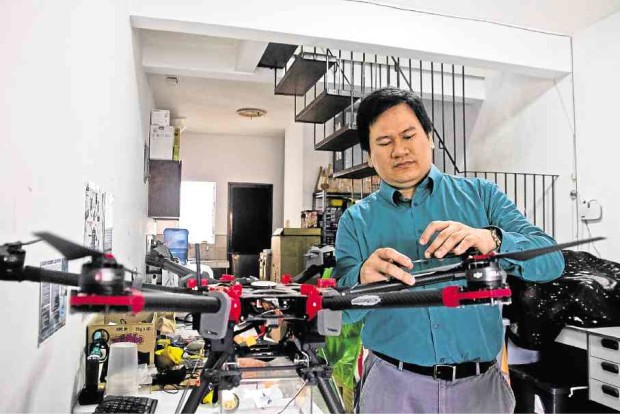LOS BAÑOS, LAGUNA—Rogel Mari Sese says he already knew what field he wanted to pursue even before he was 5.
Some of the first books he was given as a child were about astronomy and space. His mother, a biological sciences professor at the University of the Philippines Los Baños (UPLB) in Laguna province, taught him how to splice DNA when he was 11, but he says, “It never [pricked] my interest. It was always space.”
Now an astrophysicist and former program leader for the government’s National Space Development Program (NSDP), Sese says the idea of establishing the country’s own space agency is a necessity “to ensure the existence and the security of a country, of a nation.”
“The public’s perception when it comes to space is that it is expensive, but right now, [conquering] space is no longer a luxury,” he says. “If you forgo that, you’re putting your whole country at risk because you’ll be forever reliant on other countries.”
Sese is one of only three Filipino astrophysicists at present and works with the Department of Science and Technology (DOST) to establish the country’s own space agency.
His program, under the DOST’s Philippine Council for Industry, Energy and Emerging Technology Research and Development, lays the groundwork for that agency.
The scientist also runs Regulus SpaceTech Inc., which is involved in space research and development, education and consultancy.
Self-taught
Everything about space and astronomy Sese learned as a boy and on his own.
“There was no one to teach me. So even observing the stars, everything was self-study. It was more difficult back then because there was no internet yet. Encyclopedia and books that are available in the library—those were my only resources,” he says.
When Sese was about to enter college in the 1990s, there were no degree programs in astronomy or space science in the Philippines. He decided to pursue applied physics at the UPLB, saying it was the closest program to his interest in space.
After obtaining his degree, Sese taught at the university while taking a master’s degree in physics at UP Diliman in Quezon City. He went to the University of Tsukuba in Japan to work on his doctorate in physics, which he completed in 2009, at the age of 27.
Crossroad
While in Japan, Sese was at a crossroads: to stay there or return to the Philippines. He realized that he could contribute more by going home; astrophysics had yet to be developed in the Philippines because those trained in the field chose to stay abroad.
“Precisely, that’s the reason [that prompted me to] return,” he says.
In 2011, Sese went back to lay the groundwork for the country’s space agency and to encourage other scientists to come home and contribute.
Now 35, he is married and has two children.
Many are still surprised to learn that he is already at this level in his career. His batch mates at UP Rural High School would recall their days of cutting classes but would express disbelief in his stature as one of the prime movers of a Philippine space agency.
Space agency challenge
According to Sese, creating a space agency from scratch is no easy feat, but he is up to the challenge.
Learning about space should start at the basic education level, he says.
“Almost every child goes through a stage where they want to become an astronaut, where they become fascinated with the stars, the moon and the other planets. It’s just not nurtured because the environment is against it,” he says.
“So that’s what we’re trying to change right now, to show that there is an opportunity for future careers in space,” he adds.
Sese underscores the importance of science teachers in developing and sustaining interest in space education in the country. “[They are] the givers of knowledge and of moral support that these students are going to need for them to embark [on] their careers as space scientists, astrophysicists, astronomers and aerospace engineers,” he says.
Government support is essential for the space program to take off, he adds.
Congress support
Most scientists may struggle in making lawmakers understand and appreciate the work they do, but Sese says “You have to deal with policy .someone has to do it.”
Six measures—House Bill No. 3637, which was filed by Rep. Erico Aristotle Aumentado and Rep. Seth Frederick Jalosjos; HB 4275 by Representatives John Marvin Nieto and Edward Vera-Perez Maceda; HB 4367 by Rep. Joey Salceda; HB 4623 by Rep. Maximo Rodriguez Jr.; Senate Bill No. 1211 by Sen. Bam Aquino; and SB 1259 by Sen. Loren Legarda—aim to legislate a Philippine space development and utilization policy and to create a Philippine Space Agency.
“There are future trends that we need to keep track [of], and space is one of them. If we don’t do this now, we’re going to be left behind. It’s going to put the whole country at risk, that we don’t have access to space,” Sese warns.
Sparking public interest
The benefits of the Philippines having its own space agency, aside from bringing national pride, may not be apparent to the public, Sese says, but the applications of space technology are more common than what people think.
Space technology can be and is already being used in communications, environmental monitoring, disaster management, climate research, food security, and national security, he says.
Establishing a Philippine space agency can open opportunities for employment and stop the “brain drain,” according to Sese.
He hopes that someday the Philippines would have its own astronaut. “There’s no other career in the field of sciences that can have the same public appeal in the same way as [boxing champion and senator] Manny Pacquiao or [actress] Kris Aquino, other than an astronaut,” he says.
Pursuing space science “is not just about going to Mars or going to the moon,” Sese says. “It’s making sure that we take care of the earth and ensure the survival of the human race as a whole.”
